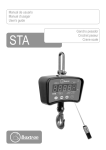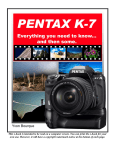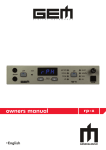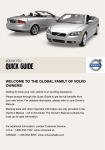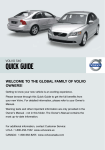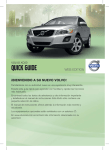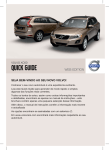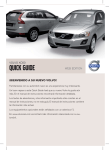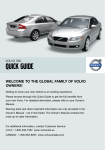Download Volvo 2012 XC60 Owner`s manual
Transcript
REMOTE KEY WITH PCC* – personal car communicator Locks the doors and tailgate and arms the alarmA. Unlocks the doors and tailgate, and disarms the alarm B Tailgate: press to unlock the tailgate. Approach lighting illuminates lights in door mirrors, cabin, footwells, license plates. Turn signals and parking lights illuminate. “Panic” alarm. – Press and hold to sound the alarm. Turn off alarm with unlock button. Information about the vehicle can be gathered within a range of 300 ft. (100 m). – Press the button and wait for 7 seconds. If the vehicle is out of range when the button is pressed, the most recently stored status information will be shown. PCC* 1 Green light: vehicle is locked. 2 Yellow light: vehicle is unlocked. 3 Red light: alarm has been triggered. 4 Alternatively flashing red lights: the alarm A The accessory inclination and movement alarm sensors can be turned off. See the “Alarm” section of your owner’s manual for information. B Automatic relock occurs if no door/tailgate is opened within 2 minutes after unlock. was triggered less than 5 minutes ago. Starting the engine – Holding the end of the remote key with the base of the key blade, insert the remote key into the ignition slot and press it in as far as possible. – Press the brake pedal. COLDSTART – Press the START/STOP/ ENGINE button briefly to start the engine. note After cold starts, your engine will idle at a higher speed for a short time. Switching off the engine and removing the remote key 1. Park the vehicle and press the START/STOP ENGINE button to switch off the engine. 2. Pull the remote key out of the ignition slot. Blind Spot Information System (BLIS)* If the BLIS indicator lights illuminate even when there are no vehicles in the blind area, this may be due to light reflected from a wet road surface, the vehicle’s own shadow against a large, light, smooth surface, or sunlight directly in the camera when the sun is low on the horizon. If there is a fault with the system, Blind spot syst. Service required will be displayed. ignition modes 0 and i To access the following ignition modes: The brake pedal must not be depressed. Modes Active functions Remote key not fully pressed into slot: infotainment system and cabin lighting. Remote key fully pressed into slot: Instrument panel/clock lighting, steering wheel lock off. Remote key fully pressed into slot and a short press on START/STOP ENGINE: moonroof*, power windows, blower, ECC, wipers, 12-volt sockets, navigation system*. To exit modes 0/I and turn off the electrical system: Pull the remote key out of the ignition slot. KEYLESS drive* On keyless drive vehicles, it is only necessary to have a remote key in your possession to operate the central locking system and start the engine. LOCKING AND ARMING THE ALARM – Press the button on any of the outside door handles or the rubber-covered button to the right of the tailgate opening button. The lock indicator light on the dashboard will start to flash. UNLOCKING AND DISARMING THE ALARM – Pull a door handle to unlock and open the door or press lightly on the larger of the two rubberized buttons on the tailgate. STARTING THE ENGINE – With a remote key in the passenger’s compartment, depress the brake pedal. – Press and release the START/STOP ENGINE button. The autostart function will operate the starter motor until the engine starts. SWITCHING OFF THE ENGINE – Press briefly on the START/STOP ENGINE button. on Infotainment 1 Turn to adjust volume. 2 Press and hold for ON/OFFA. Press briefly to mute/unmute. 3 Press to choose AM, FM1, etc. 4 Press MEDIA to choose Disc, AUX/ USBB, etc. 8 Press for sound settings such as Bass, Treble or Center console display main view 1 Infotainment systems modes (RADIO, MEDIA, TEL, etc). Press and hold EXIT for several seconds to display. 2 The selected mode’s main functions. In the example above, Radio mode is selected and the various radio wavebands are displayed. Surround* – Turn VOL (1) to adjust. RADIO 6 Turn to choose a station. For FM1/FM2, an automatically generated list of the strongest stations is displayed. 7 Search for stations with the left/right arrow keys. Press and hold to find the strongest stations. Press briefly to tune to preset stations. Store up to 10 stations each for FM1/FM2/AM by holding in buttons 0–9 until the stored station is confirmed in the display. CD/DVD player 5 Press to eject a disc. 6 Turn to select CD tracks from the list. 7 Change CD tracks by pressing the left/right arrow keys briefly. Press and hold for fast forward/back. Navigating the menus 1 Left/right arrow keys: Press briefly to search for the next radio station, change tracks on a disc, etc. Press and hold to search within the track that is currently playing. 2 Volume buttons 3 EXIT: Press briefly to go one step higher in the menu system, interrupt a function, reject an incoming call, etc. Press for approx. 1 second to return to the selected mode’s main menu. aux and usb 4 Thumb wheel: turn up or down to scroll through An iPod®C or MP3 player can be connected to the infotainment system through the AUX or USB sockets in the center console. An iPod® connected through the USB socket will also be charged. 5 Voice buttonD: used for various cell phone func- HD radio HD radio reception is subject to coverage limitations. See your Owner’s Manual for details. A cell phone will be disconnected if the infotainment system is switched off. A B AUX/USB sockets for e.g., mp3 player. Set the device’s volume to medium for best sound quality; adjust with TUNE (6). C iPod® is a registered trademark of Apple Computer Inc. the menus displayed. Press to confirm a selection (OK) or to answer an incoming call (if a Bluetooth-enabled cell phone is connected). tions and for the optional navigation system. Select a mode by turning the thumb wheel on the steering wheel keypad and press the thumb wheel to confirm. Continue by turning the thumb wheel to select one of the mode’s functions. Press the thumb wheel to confirm. An arrow to the right indicates a submenu. Navigate in the submenus in the same way. See the Infotainment chapter in your owner’s manual for detailed information. D On models not equipped with the navigation system*, this button mutes/unmutes infotainment system sound. electronic climate control—Ecc AUTOMATIC CONTROL In AUTO mode, ECC controls all functions automatically and makes driving more pleasant with optimal air quality. 1 Turn the control to the desired temperature on the left/right sides of the cabin. The set temperature is shown in the display. 8 Press to automatically control the temperature and other functions. MANUal control 2 Heated driver/front passenger seat*. 3 Max. defroster. Directs maximum air flow to the windshield and front side windows. 4 Blower speed. 5 Air distribution. 6 Heated rear window and door mirrors. 7 Recirculation. 9 Air conditioning Off/On to cool the cabin and defog the windows. Storage spaces, 12-volt sockets & AUX/usb connector The 12-volt sockets in the cabin function in ignition modes I or II. The 12-volt socket* in the cargo area always functions. AUX/USB can be used to connect e.g., an mp3 player to the vehicle’s infotainment system. caution Using the optional 12-volt socket in the cargo area with the engine switched off will drain the battery. laminated panoramic roof* The first press on the control operates the sun shade; the second press operates the laminated panoramic roof. The sun shade must be fully open before the laminated panoramic roof can be opened manually. When the laminated panoramic roof is opened to the tilt (ventilation) position, the sun shade opens/closes automatically. A Auto open B Manual open C Manual close D Auto close E Open to the tilt position F Close from the tilt position odometer and trip computer 1 The display shows two separate trip odometers, T1 & T2. 2 Fuel gauge The fuel filler door is on the right, as indicated by the arrow. 3 Low fuel level indicator When the symbol illuminates, refuel as soon as possible. 4 Trip computer display. Select function with (8). 5 Clock: Adjust in the MY CAR menu system or with control (6). 6 Multi-function control Turn the control clockwise or counterclockwise to set the clock. A short press toggles between T1 & T2. A long press resets the displayed odometer. Setting the clock: turn as far as possible and continue turning until a click is audible. steering wheel adjustment 7 Press to display or erase a message. 8 Turn to show trip computer information alternatives. 9 A short press resets the current function. A long press resets all functions. note The display text Miles to empty tank is an approximation, based on recent average fuel consumption. Bluetooth 1. Make the cell phone discoverable/visible. 2. Press the TEL button on the center console control panel briefly. 3. Select “Add phone” in the display. 4. Select the cell phone to be connected. 5. Enter the numbers shown in the audio system display using the cell phone’s keypad. 1. Release lock. 2. Adjust. wARNING Never adjust the steering wheel while driving. A cell phone will be disconnected if the infotainment system is switched off. Lighting panel Display & instrument panel lighting. Rear fog light (driver’s side only). Automatic headlights. High beam flash only. Parking lights Headlights: turn off when ignition is switched off, high/low beams. Open the fuel filler door. A B High beam flash PPress once to unlock the tailgate (also opens the tailgate on models with the power tailgate*). Toggle between high/low beams. Home safe lighting. driver support systems warning city safety™ and collision warning with full auto-brake And pedestrian detection* These features help the driver avoid a collision in situations where changes in the traffic ahead combined with driver distraction could result in an accident or other traffic-related incident. City Safety™ functions at speeds up to 18 mph (30 km/h) and assists the driver by monitoring the vehicle ahead using a laser sensor mounted in the upper section of the windshield. City Safety™ can help prevent a collision if the difference in speed between your vehicle and the vehicle ahead is less than 9 mph (15 km/h). If the difference in speed is greater, a collision cannot be avoided but the speed at which the collision occurs can be reduced. City Safety™ is designed to intervene as late as possible to help avoid unnecessary activation. The driver is always responsible for operating the vehicle correctly and for keeping a safe distance to the vehicle ahead. City Safety™ is a supplemental aid to the driver. It can never replace his/her attention to traffic conditions or responsibility for operating the vehicle in a safe manner. Pedestrian detection does not provide warnings and braking action at speeds above 50 mph (80 km/h). It does not function in darkness and in tunnels and cannot detect pedestrians who are partially hidden, who are less than 32 in. (80 cm) tall or who are wearing clothing that obscures the contours of their bodies. OTHER DRIVER SUPPORT SYSTEMS* The vehicle may be equipped with a number of other optional systems that help the driver e.g., brake in time, keep a safe distance to the vehicle ahead, detect another vehicle moving in the same direction as your vehicle in the side-view mirror’s “blind area” or stay in a traffic lane. These include: • Adaptive Cruise Control* • Distance Alert* • Blind Spot Information System (BLIS)* • Driver Alert System* • Lane Departure Warning* Adjusting the front seat 1 Lumbar support. 2 Backrest tilt. 3 Raise/lower the seat. 4 Raise/lower the front edge of the seat cushion. 5 Forward/rearward. 6 Folding down the passenger’s seat back- wipers and rain sensor* 1 Rain sensor On/Off with the lever in the 0 position. 2 Turn to adjust intermittent wiper speed or rain sensor sensitivity where applicable. A Single wiper sweep. 0 Off B Intermittent wipers. Turn (2) to adjust interval. C Normal wiper speed. D High wiper speed. E Windshield and headlight washer. F Tailgate washer. Displayed when the rain sensor is active. 3 Tailgate wiper: intermittent/normal speed. electric parking brake Setting – Press the button. The light flashes until the parking brake is fully applied, then glows continuously. Releasing 1. Ignition mode 0 or higher. 2. Press the brake pedal and pull the button gently. Release automatically – Select a gear and begin driving. The parking brake will release automatically (the driver’s seat belt must be fastened). TP 13538 (USA & Canada). AT 1120. Printed in Sweden, Göteborg 2011. Copyright © 2000-2011 Volvo Car Corporation. rest. See the Owner’s Manual for more information. VOLVO XC60 Quick guide WELCOME TO THE GLOBAL FAMILY OF VOLVO OWNERS! Getting to know your new vehicle is an exciting experience. This Quick Guide provides a brief overview of the most common features and functions in your Volvo. However, for the most up-to-date and detailed descriptions and instructions, as well as important warnings and other information not included in this folder, please refer to your Owner’s Manual. An asterisk (*) indicates optional equipment. For additional information, contact Customer Service: U.S.A.: 1-800-458-1552 www.volvocars.us Canada: 1-800-663-8255 www.volvocars.ca









